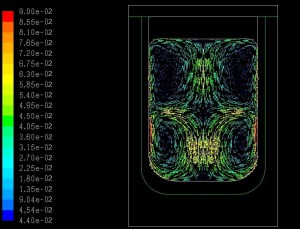Induction melting is one of the most important areas of application for induction technology. The high melting capacity in combination with a bath movement driven by electromagnetic forces, which leads to a mixing of the melt that is conducive to the process, are just some of the numerous advantages.
Numerical modeling, analysis and optimization for inductive melting and electromagnetic stirring
Due to the interacting physical fields and the resulting complicated relationships during inductive melting, we use modern CFD methods for process analysis and optimization.
The abbreviation CFD stands for Computational Fluid Dynamics. It refers to the computer-aided investigation of fluid dynamics problems. We are constantly confronted with fluid dynamic processes in our everyday lives. A good example of this is the flow of air masses in the atmosphere, on whose effects our weather depends.
In many cases, it is important to optimize a product or process from a fluid dynamic perspective, such as in the design of wings in aircraft construction or the aerodynamics of vehicles.
Especially with fluids of very low viscosity or in the case of high flow velocities - such as in a coreless induction furnace - we are dealing with turbulent flows, which are characterized by randomly fluctuating turbulence and can take on very complex forms. In such cases, analytical calculations are no longer possible. Only with special programs and usually high computing power is it possible to deal with such problems, which falls within the scope of CFD.
What advantages does CFD offer with regard to inductive melting and electromagnetic stirring?
Using special CFD software, complex fluid dynamic processes can be virtually reproduced and simulated on the computer. This makes it possible to gain a detailed insight into the physical processes and interactions, such as mechanical and thermal loads. Time-consuming and cost-intensive experimental investigations can be greatly reduced, and data can also be obtained in this way even at points that cannot be measured.
What can we do for you?
We generate a virtual model for your process in which all relevant physical influencing factors and interactions are taken into account. Based on this, we create numerical simulations and analyze the data obtained. With the help of the knowledge gained in this way, we show you all optimization and implementation options and advise / support you during implementation.
Examples of inductive melting:
Induction melting in the cold-wall induction crucible furnace: formation of a layer of solidified melt on contact with the intensively cooled crucible | |
|---|---|
Induction melting in the crucible induction furnace: steady-state flow velocity |  |
Have we aroused your interest? If you have any questions, please do not hesitate to contact us on 06202/8598456. Please send your inquiries to info@eltatech.de or use our convenient contact form.
